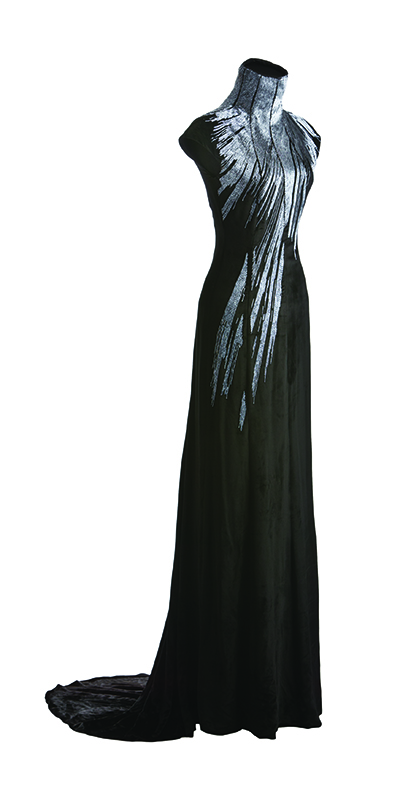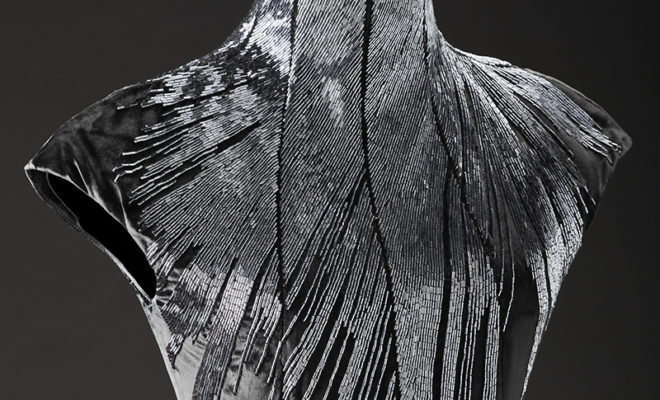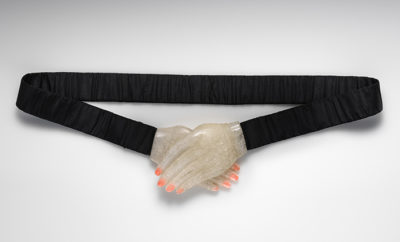ON JULY 19, 1692, ELIZABETH JACKSON HOWE was hanged in Salem, Massachusetts, a victim of the witchcraft hysteria that divided neighbors and sent nineteen innocent people, mainly women, to their deaths. More than three centuries later, the fashion designer Lee Alexander McQueen and his creative director Sarah Burton visited Salem. It happened that McQueen’s mother had traced their family tree to Howe, and McQueen was looking for information. The result was his intensely personal Autumn–Winter 2007 ready-to-wear collection, “In memory of Elizabeth Howe, Salem, 1692.”

Dress from “In memory of Elizabeth Howe, Salem, 1692” collection by Lee Alexander McQueen (1969–2010). Velvet and satin, 2007/2008. WALTER SILVER PHOTO, © PEABODY ESSEX MUSEUM, 2012.
Drawing on pagan symbolism, McQueen designed a starburst in hand-sewn, iridescent gunmetal-gray bugle beads radiating down the neckline and across the chest and shoulders of this form-fitting velvet dress. “It was a very personal collection for Lee,” Burton wrote in the catalogue that accompanied McQueen’s posthumous exhibition Alexander McQueen: Savage Beauty at the Metropolitan Museum of Art in 2011, “but then Lee always used to say that his work was autobiographical.”
McQueen attended Central Saint Martins in London and apprenticed on Savile Row prior to opening his own house in 1993. Savage Beauty opened just a year after his untimely death in 2010 and remains one of the best-attended exhibitions in the Met’s history.
Petra Slinkard
Nancy B. Putnam Curator of Fashion and Textiles
Peabody Essex Museum
Salem, Massachusetts
 DRESS FROM “IN MEMORY OF ELIZABETH HOWE, SALEM, 1692” COLLECTION by LEE ALEXANDER MCQUEEN (1969–2010). Velvet and satin, 2007/2008. WALTER SILVER PHOTO, © PEABODY ESSEX MUSEUM, 2012.
DRESS FROM “IN MEMORY OF ELIZABETH HOWE, SALEM, 1692” COLLECTION by LEE ALEXANDER MCQUEEN (1969–2010). Velvet and satin, 2007/2008. WALTER SILVER PHOTO, © PEABODY ESSEX MUSEUM, 2012.
 DRESS FROM “IN MEMORY OF ELIZABETH HOWE, SALEM, 1692” COLLECTION by LEE ALEXANDER MCQUEEN (1969–2010). Velvet and satin, 2007/2008. WALTER SILVER PHOTO, © PEABODY ESSEX MUSEUM, 2012.
DRESS FROM “IN MEMORY OF ELIZABETH HOWE, SALEM, 1692” COLLECTION by LEE ALEXANDER MCQUEEN (1969–2010). Velvet and satin, 2007/2008. WALTER SILVER PHOTO, © PEABODY ESSEX MUSEUM, 2012.











